· 8 min read
Mobile playtime increases by 62%, with IAP up by around 30% in Q1

Ioana Hreninciuc
Former CEO at GameAnalytics
As millions of people work from home or are on furlough, they’ve needed something to pass the time: streaming TV shows, learning instruments and, of course, playing games. At least, that’s the assumption. We dug into our data to find that playtime has soared and people are spending more, but each genre is affected differently.
We’ve analyzed our data in two ways
1. Global network analysis
Our first approach was to look at the overall data across our network. Over 75,000 developers use GameAnalytics to analyze how gamers are playing. That’s about 40,000 active mobile games, all in all, including 40 of the top 100 most downloaded games on the app stores. By combining all this data, we can see how more than a third of the world’s mobile players are behaving.
Specifically, we analyzed playtime and how much people were spending.
2. Findings from Benchmarks+
The second approach was to use Benchmarks+ to drill down into how specific genres are performing. This is something that you can investigate yourself, to check out the current state of the industry across different metrics, genres, regions, and platforms. With this approach, we looked at which genres have the most playtime, how many players are converting and what the retention looks like.
So let’s get into it.
Playtime has increased by a whopping 62%
Over the last three months, we’ve seen traffic go up by nearly half (46%), from 1.2 billion people playing every month to 1.75 billion. But it’s not just the number of players that’s skyrocketed. Globally, the total amount of playtime hit a peak of over 90 million hours in the last ten days of March, 62% higher than the first ten days of January. That’s enough time to binge the entire Lord of the Rings trilogy 10 million times. Obviously, part of this is because more people are playing. But on average people are playing for longer, too.
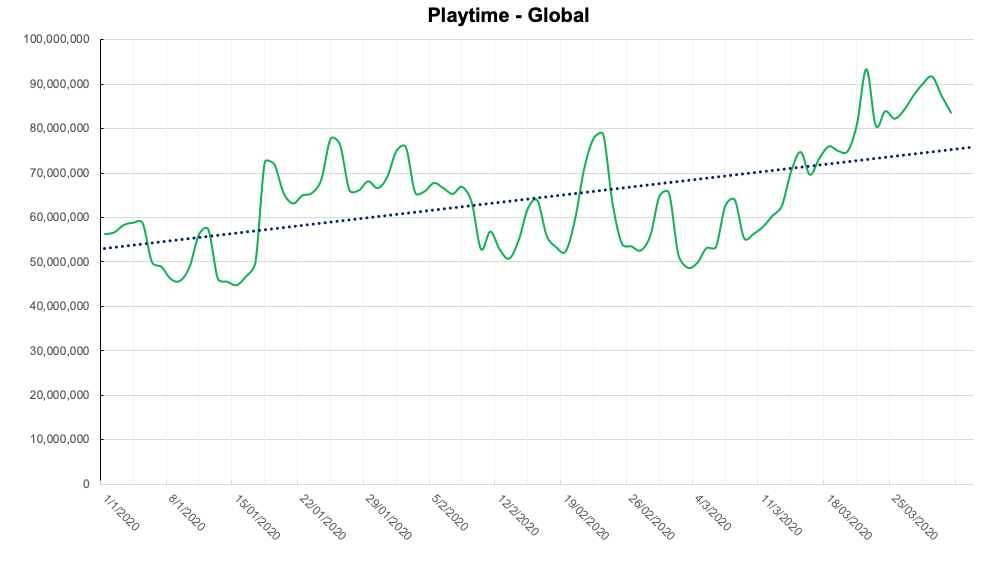
As you can see, this growth has had its peaks and troughs. It starts off consistent with what we usually see between week and weekend traffic (interestingly, there are fewer weekend spikes in March). In addition, those earlier spikes coincide with specific announcements and they tend to level out higher than before. For example, in the second half of January, there was a surge from China. In this time, the global playtime soared by 40%, then dipped back 20% – still higher than before China’s lockdown.
Then, on the 21st of February, we saw a second spike when Italy locked down. Later, there’s a third that coincides with the European and North American lockdown. We went ahead and represented the same data in a different way to really highlight the impact of these global events.
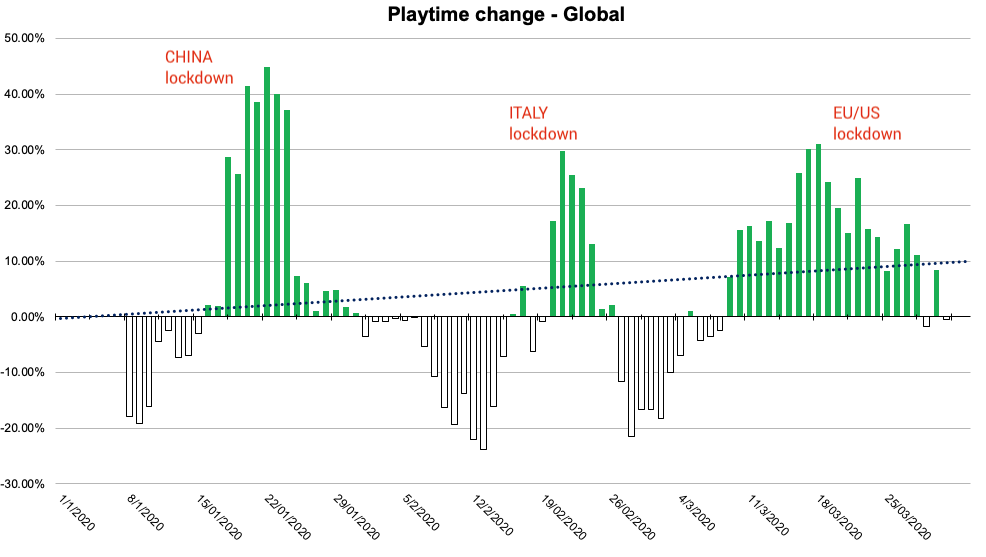
Bear in mind, this graph highlights the relative change, not negative values (think of the stock market ticker). So essentially here you’re viewing the percentage change from the previous day, and the average playtime for this period is still up to 62% higher than it was before the outbreak.
It’s not the lockdown, but the announcements
The lockdowns alone don’t explain these spikes. Take Italy. There just aren’t enough players in the region to result in such a seismic shift. No, this is a little more subtle. We think it’s the announcement itself that’s caused this surge. The news about the lockdown had a much stronger impact than the local measures did on how people behaved. How? Perhaps others, in different regions across the world, started preemptively working from home. Or maybe people were just looking for more of a distraction.
In the following days, we notice that this growth very quickly starts to reverse, just as it did after China’s measures. But when stricter measures were enforced across the world, the numbers picked back up, and seem to be growing for a much longer period of time. This sustained growth is more likely directly linked to people being holed up indoors.
People are spending more, too
The amount of people that are spending on in-app purchases has also gone up. This could be because more people are playing, so there’s a bigger chance someone will spend something. But playtime comes into the equation as well: the longer people play, the more likely they’ll spend. So existing players are likely to be spending more, too.
That’s born out in the facts. In-app purchases have followed a very similar pattern to playtime. While there’s a clear increase at the beginning of the year, the real difference didn’t really start until social distancing measures were introduced in Europe and North America. So, for most of March, the growth was between 5% and 30% a day.
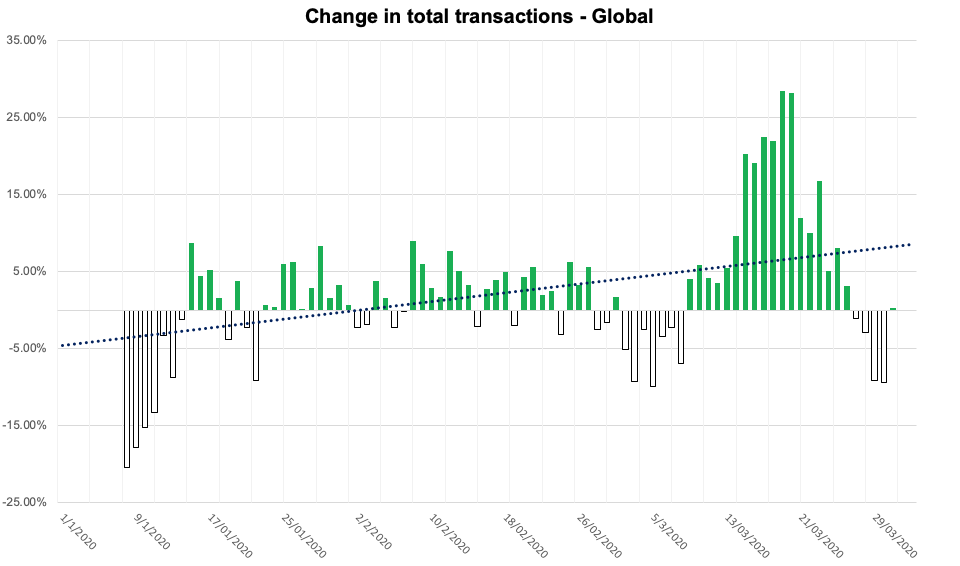
Interestingly, this wasn’t on weekends. The peak was during the workweek of March 16th to 20th – when pretty much the whole of Europe went into lockdown.
This is probably down to a combination of factors. Clearly, boredom. But it’s possible that people are also justifying spending a little more freely on in-app purchases when they’re not splashing out on the weekends at department stores, or the local pub.
How does this play out at the genre level?
Using Benchmarks+, we drilled down and looked at how different genres are performing. We’ve gone ahead and highlighted three particularly notable findings for you, specifically across adventure, puzzle and hyper-casual genres.
1. Adventure games are doing particularly well
When we dig deeper into Benchmarks+, we start to confirm a few of our theories: namely, that players are whiling away the boredom with games. Playtime is typically longer for the adventure genre, due to its more involved experience. And the top 2% in the genre have grown by 25% – with the most avid of players now playing a staggering 4 hours (245 mins) per user on average.
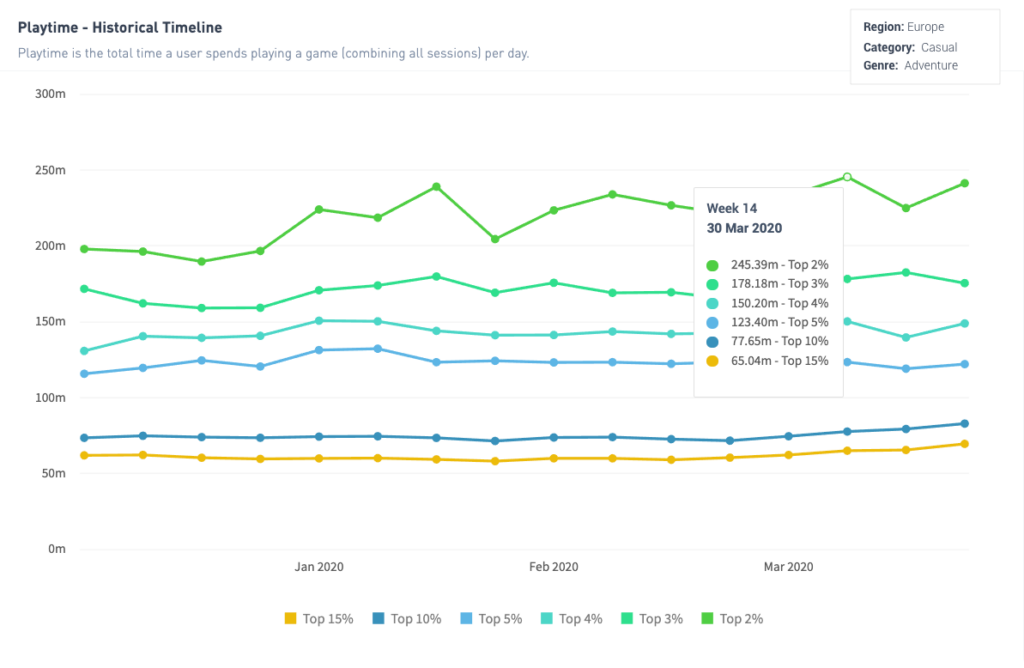
The adventure genre shows a surge in popularity that most closely follows the industry-level trends. It would seem that, with a lot of time on their hands, people are opting to play longer, more in-depth games to keep themselves occupied.
But this could be taking playtime away from other genres.
2. Hyper-casual games are growing, but slower
Arcade-style, hyper-casual games have grown from 8% to around 10% since January, with playtime per user going from 71 minutes at the start of the year, to 81 minutes in March for the top 2%.
We expected to see a bigger increase here, but this small rise could be because content is limited. If players want to stifle the boredom, there just might not be enough content in a hyper-casual game to entertain them for long enough. They might hit the end relatively quickly, especially as the genre is meant to be short and sweet. You don’t need a snackable game when you’re starving.
3. Arcade games are converting well
The genre peaked at around 3% conversion. Perhaps this is because of the increased playtime, and so more users are looking to buy their way into ad-free experiences or to play for longer with more lives and turns.

4. But other games have dropped
Action, adventure, puzzle and casual games all saw a small drop in conversion of about 1%, going from 5.6% earlier in the year to about 4.6% now. (That’s based on the top 2% of games.)
There’s a very similar pattern when you go to mid-core games: their conversion dipped and then started to recover in the last few days.
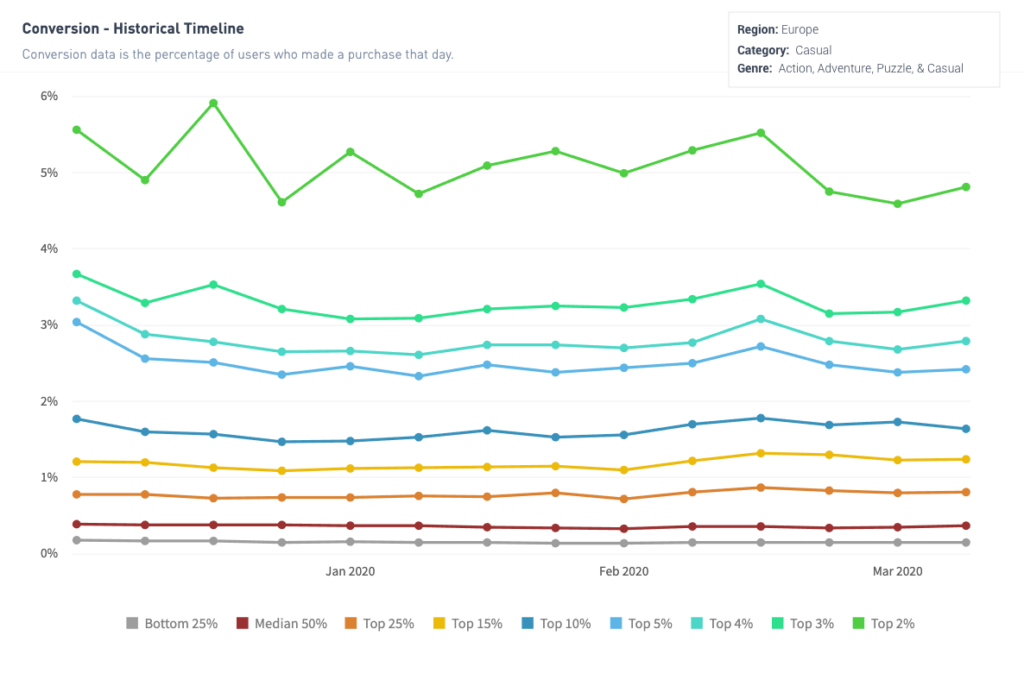
It’s hard to say if people are sticking to a game
Knowing when people are dropping off your game is important. But this is such a fast-moving crisis that we just don’t yet have the data to know how it’s affected retention.
D7 retention has dropped from 30% to 26% across the industry. We’ll keep an eye on it and see if this is a trend or a blip. This could just be that people are trying lots of games, before they settle onto one. Or maybe they’re ploughing through the content much quicker than usual.
We’re at a time where people are playing more than ever. It’s perfectly possible that our time-frames are getting squeezed: where a player who would spend a month on your game can get through the same content in a week.

Delve into your own genre
The second approach we took was by using the same filters that are available to you in Benchmarks+. We’re just looking at the tip of the iceberg here, so if you’d like to learn more about accessing these insights and how they could help you stay in tune with industry changes, you can find out more and book a demo here.